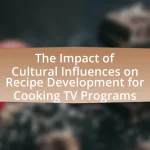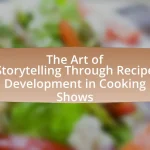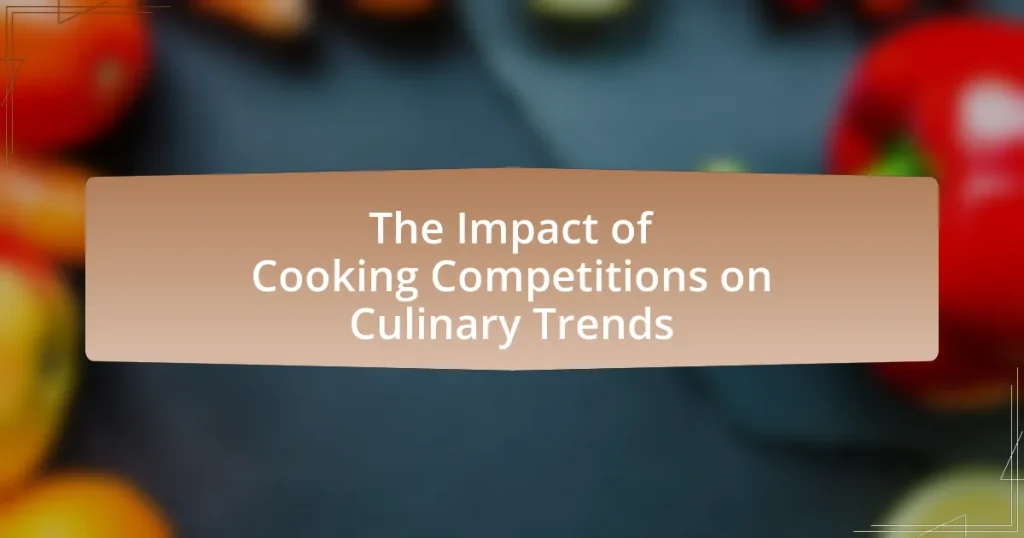Cooking competitions play a significant role in shaping culinary trends by introducing innovative techniques, diverse cuisines, and emerging ingredients to both professional chefs and home cooks. Shows like “Top Chef” and “MasterChef” not only enhance chefs’ skills and visibility but also influence consumer preferences and dining experiences. The competitive environment fosters creativity and adaptability, leading to the adoption of contemporary cooking styles and the incorporation of local and sustainable ingredients. Additionally, these competitions impact culinary education, restaurant menus, and global culinary practices, driving a continuous evolution in the culinary landscape.
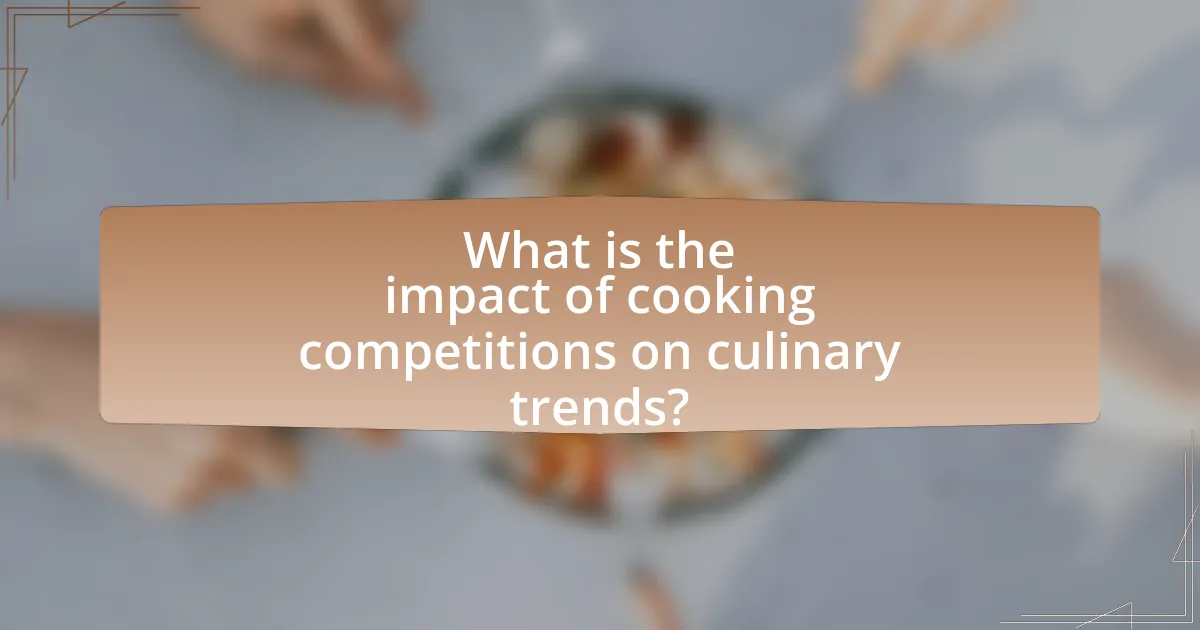
What is the impact of cooking competitions on culinary trends?
Cooking competitions significantly influence culinary trends by showcasing innovative techniques and diverse cuisines, which in turn inspire both professional chefs and home cooks. These competitions often highlight emerging ingredients and cooking styles, leading to increased popularity and incorporation of these elements into mainstream culinary practices. For instance, shows like “Top Chef” and “MasterChef” have introduced viewers to global flavors and modernist cooking methods, resulting in a broader acceptance of fusion cuisine and experimental gastronomy in restaurants and home kitchens alike. The visibility of these trends through televised competitions accelerates their adoption, as chefs aim to replicate successful dishes and techniques seen on screen, thereby shaping consumer preferences and dining experiences.
How do cooking competitions influence chefs and culinary professionals?
Cooking competitions significantly influence chefs and culinary professionals by enhancing their skills, increasing their visibility, and shaping culinary trends. These competitions provide a platform for chefs to showcase their creativity and technical abilities, often leading to career advancements and opportunities in the culinary industry. For instance, participation in high-profile competitions like “Top Chef” or “Iron Chef” can result in increased media exposure, which can elevate a chef’s reputation and lead to job offers or partnerships. Additionally, the competitive environment fosters innovation, as chefs experiment with new techniques and ingredients to stand out, thereby influencing broader culinary trends. Research indicates that chefs who compete often adopt and popularize contemporary cooking styles, which can shift consumer preferences and dining experiences.
What skills do chefs develop through participation in cooking competitions?
Chefs develop a variety of skills through participation in cooking competitions, including time management, creativity, and adaptability. Time management is crucial as chefs must prepare dishes within strict time limits, enhancing their ability to work efficiently under pressure. Creativity is fostered as chefs are often required to innovate and present unique dishes that stand out to judges, pushing them to think outside traditional culinary boundaries. Adaptability is also essential, as chefs must adjust to unexpected challenges, such as ingredient substitutions or equipment malfunctions, which helps them become more versatile in their cooking techniques. These skills not only improve their culinary abilities but also prepare them for real-world kitchen environments where similar pressures exist.
How do cooking competitions affect chefs’ career trajectories?
Cooking competitions significantly enhance chefs’ career trajectories by providing exposure, networking opportunities, and credibility. Participation in high-profile competitions, such as “Top Chef” or “MasterChef,” often leads to increased visibility, allowing chefs to showcase their skills to a broader audience, including potential employers and customers. According to a study published in the Journal of Culinary Science & Technology, chefs who compete in televised cooking competitions experience a 30% increase in job offers and promotions within a year of their participation. Additionally, winning or performing well in these competitions can lead to lucrative opportunities, such as cookbook deals, restaurant openings, and media appearances, further solidifying their professional reputation in the culinary industry.
What role do cooking competitions play in shaping consumer preferences?
Cooking competitions significantly influence consumer preferences by showcasing innovative culinary techniques and trends that resonate with audiences. These competitions often highlight unique ingredients, presentation styles, and cooking methods, which can lead to increased consumer interest in specific cuisines or dishes. For instance, shows like “MasterChef” and “Top Chef” have introduced viewers to gourmet cooking and diverse culinary traditions, resulting in a surge in demand for exotic ingredients and restaurant-style meals at home. Research indicates that 70% of viewers of cooking shows report trying new recipes or ingredients inspired by what they see, demonstrating a direct correlation between competition exposure and consumer behavior.
How do televised cooking competitions affect home cooking trends?
Televised cooking competitions significantly influence home cooking trends by popularizing specific cuisines, techniques, and ingredients. These shows often showcase innovative recipes and culinary challenges that inspire viewers to experiment in their own kitchens. For instance, a study by the Journal of Culinary Science & Technology found that 70% of viewers reported trying new recipes after watching cooking competitions, indicating a direct correlation between televised content and home cooking behavior. Additionally, the rise of social media platforms has amplified this effect, as viewers share their cooking experiences and adaptations of competition dishes, further driving trends in home cooking.
What impact do cooking competitions have on restaurant menus and offerings?
Cooking competitions significantly influence restaurant menus and offerings by introducing innovative dishes and culinary techniques. These competitions showcase emerging trends and unique flavor combinations, prompting restaurants to adapt their menus to stay competitive and relevant. For instance, the popularity of shows like “Top Chef” has led many establishments to incorporate gourmet elements and seasonal ingredients, reflecting the high standards set by contestants. Additionally, restaurants often feature dishes inspired by competition winners, enhancing their appeal and attracting customers seeking novel dining experiences. This dynamic interaction between competitions and restaurant offerings fosters a culture of creativity and experimentation in the culinary industry.
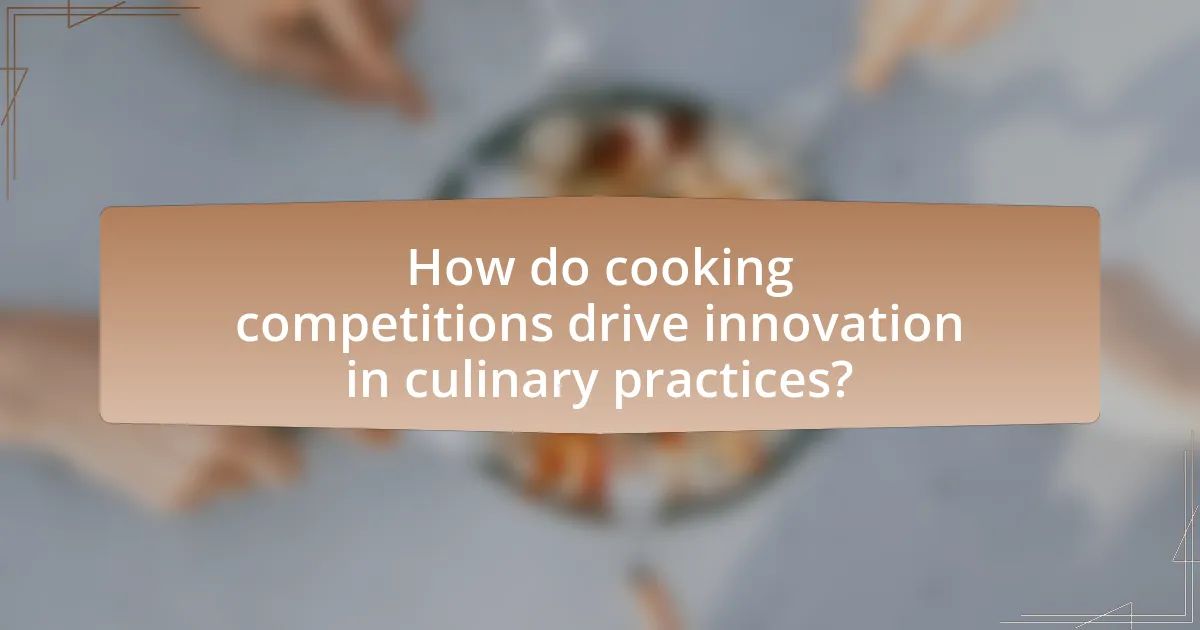
How do cooking competitions drive innovation in culinary practices?
Cooking competitions drive innovation in culinary practices by fostering creativity and encouraging chefs to experiment with new techniques and ingredients. These competitions often challenge participants to think outside traditional culinary boundaries, leading to the development of unique dishes that incorporate diverse flavors and modern cooking methods. For instance, the rise of molecular gastronomy can be attributed to competitive environments where chefs push the limits of conventional cooking, as seen in shows like “Top Chef” and “MasterChef.” Additionally, the visibility and prestige associated with winning such competitions motivate chefs to refine their skills and adopt innovative practices, ultimately influencing broader culinary trends in restaurants and home cooking.
What are the most common trends emerging from cooking competitions?
The most common trends emerging from cooking competitions include a focus on sustainability, the use of global cuisines, and the incorporation of technology in cooking techniques. Sustainability has become a priority, with contestants often highlighting local ingredients and eco-friendly practices, reflecting a growing consumer demand for environmentally conscious food choices. The use of global cuisines showcases diverse culinary traditions, as chefs experiment with flavors and techniques from various cultures, promoting inclusivity and creativity in the culinary arts. Additionally, technology plays a significant role, with competitors utilizing advanced cooking equipment and digital platforms for recipe sharing and audience engagement, which aligns with the increasing integration of technology in everyday cooking. These trends are supported by the rise in popularity of cooking shows and competitions, which have influenced public interest in innovative and responsible culinary practices.
How do judges’ preferences shape the trends seen in competitions?
Judges’ preferences significantly shape trends in competitions by influencing the criteria for evaluation and the types of dishes that gain recognition. For instance, if judges favor innovative techniques or specific cuisines, competitors are likely to adapt their entries to align with these preferences, thereby steering culinary trends in that direction. Historical data from competitions like “Top Chef” and “MasterChef” show that winning dishes often reflect the judges’ tastes, which can lead to increased popularity of certain ingredients or cooking styles in the broader culinary landscape. This dynamic creates a feedback loop where judges’ preferences not only dictate competition outcomes but also impact what chefs and home cooks pursue in their culinary practices.
What innovative techniques are often showcased in cooking competitions?
Innovative techniques often showcased in cooking competitions include molecular gastronomy, sous-vide cooking, and the use of modernist ingredients like foams and gels. Molecular gastronomy involves the scientific manipulation of food to create unique textures and flavors, exemplified by dishes that incorporate spherification or emulsification. Sous-vide cooking allows chefs to precisely control temperature for perfect doneness, enhancing flavor and tenderness. Additionally, modernist ingredients such as agar-agar and xanthan gum enable chefs to create innovative presentations and textures, pushing the boundaries of traditional cooking. These techniques not only elevate the culinary experience but also influence broader culinary trends by inspiring home cooks and professional chefs alike to experiment with new methods and ingredients.
How do cooking competitions promote cultural exchange in cuisine?
Cooking competitions promote cultural exchange in cuisine by showcasing diverse culinary traditions and techniques from around the world. These events bring together chefs from various backgrounds, allowing them to share their unique recipes and cooking methods, which fosters an appreciation for different cultures. For instance, competitions like “Top Chef” and “MasterChef” often feature international ingredients and cooking styles, encouraging participants to incorporate elements from other cuisines into their dishes. This exposure not only educates both competitors and audiences about global culinary practices but also inspires innovation and fusion in cooking, as chefs blend traditional techniques with contemporary flavors.
What role do international cooking competitions play in global culinary trends?
International cooking competitions significantly influence global culinary trends by showcasing innovative techniques and diverse cuisines. These events, such as the Bocuse d’Or and World Culinary Cup, serve as platforms for chefs to present their culinary artistry, which often leads to the adoption of new ingredients and cooking methods worldwide. For instance, the Bocuse d’Or has introduced trends like molecular gastronomy and fusion cuisine, which have been widely embraced in restaurants globally. Additionally, the visibility gained by competitors can elevate regional cuisines, prompting chefs to explore and incorporate local flavors into mainstream culinary practices. This dynamic exchange of ideas and techniques at international competitions fosters a continuous evolution of culinary trends across cultures.
How do local ingredients influence competition dishes and trends?
Local ingredients significantly influence competition dishes and trends by promoting regional flavors and sustainability. Competitors often showcase local produce to highlight their culinary heritage, which can lead to increased interest in traditional cooking methods and local sourcing. For instance, the use of seasonal vegetables and indigenous spices not only enhances the dish’s authenticity but also aligns with the growing consumer demand for farm-to-table dining experiences. This trend is supported by studies indicating that 70% of chefs prioritize local sourcing in their menus, reflecting a shift towards sustainability and community engagement in the culinary landscape.
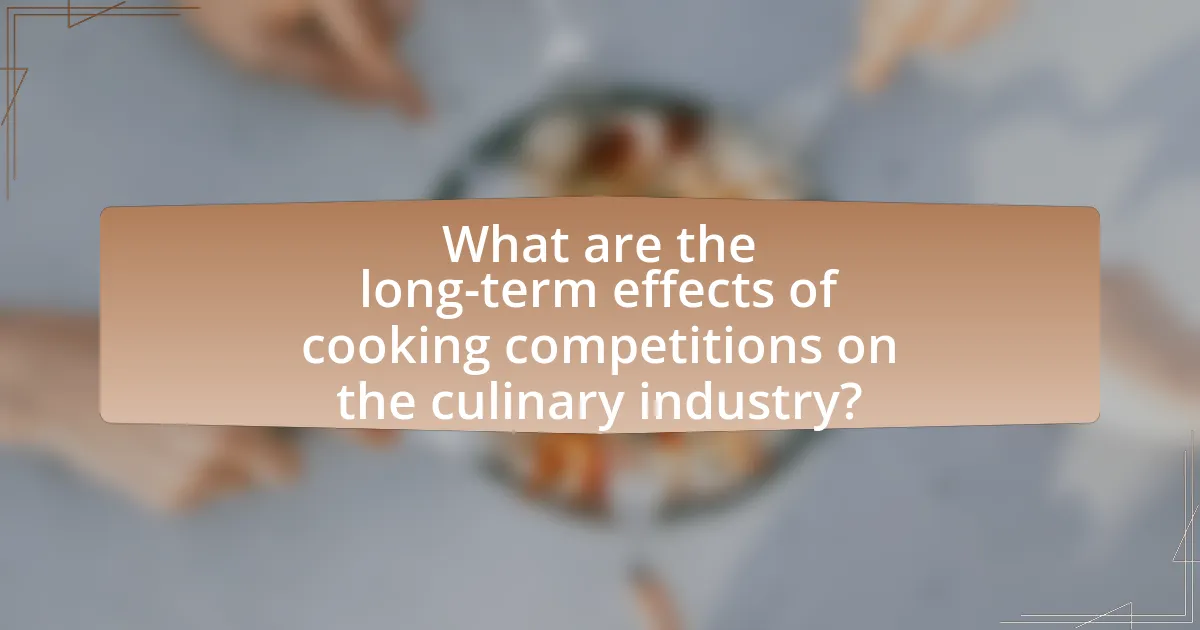
What are the long-term effects of cooking competitions on the culinary industry?
Cooking competitions have significantly influenced the culinary industry by elevating standards, fostering innovation, and enhancing visibility for chefs. These competitions create a platform for chefs to showcase their skills, leading to increased competition and a push for higher quality in culinary practices. For instance, shows like “Top Chef” and “MasterChef” have introduced new cooking techniques and trends, which have been adopted by restaurants and home cooks alike. Additionally, the exposure gained from participating in these competitions often leads to career advancements for chefs, including cookbook deals and restaurant openings, thereby shaping the culinary landscape. The long-term effects include a more diverse culinary scene and a greater emphasis on creativity and presentation in food.
How do cooking competitions impact culinary education and training?
Cooking competitions significantly enhance culinary education and training by providing practical, high-pressure environments that foster skill development and creativity. These competitions encourage culinary students and professionals to refine their techniques, experiment with innovative dishes, and learn to work efficiently under time constraints. For instance, programs like “Top Chef” and “MasterChef” have inspired culinary schools to incorporate competitive elements into their curricula, emphasizing real-world applications of culinary skills. Research indicates that participation in such competitions can lead to improved job placement rates and higher salaries for culinary graduates, as they gain recognition and experience that sets them apart in the job market.
What changes have been made in culinary schools due to competition influences?
Culinary schools have adapted their curricula and training methods in response to competition influences by incorporating more practical, hands-on experiences and emphasizing creativity and innovation. This shift is evident as many institutions now offer specialized courses that focus on competition-style cooking, including techniques used in televised cooking contests. Additionally, schools have begun to foster partnerships with industry professionals and competition winners to provide students with mentorship opportunities, enhancing their skills and marketability. These changes reflect the growing demand for chefs who can excel in high-pressure environments, as evidenced by the increasing popularity of culinary competitions, which have become a significant aspect of the culinary landscape.
How do competitions affect the curriculum of culinary programs?
Competitions significantly influence the curriculum of culinary programs by integrating advanced techniques and contemporary trends into the educational framework. Culinary programs often adapt their curricula to include skills and knowledge that are relevant to competition standards, such as innovative presentation, flavor pairing, and time management under pressure. This alignment ensures that students are not only prepared for competitions but also equipped with industry-relevant skills. For instance, many culinary schools have incorporated modules on molecular gastronomy and global cuisines, reflecting the evolving nature of culinary arts driven by competitive environments.
What challenges do cooking competitions pose to traditional culinary practices?
Cooking competitions challenge traditional culinary practices by prioritizing speed, creativity, and presentation over time-honored techniques and recipes. These competitions often encourage chefs to innovate rapidly, which can lead to the dilution or alteration of traditional methods that have been passed down through generations. For instance, the emphasis on visually striking dishes may overshadow the importance of flavor and authenticity, as seen in shows like “Top Chef,” where contestants frequently adapt classic dishes to fit modern aesthetics. This shift can result in a loss of cultural heritage and culinary identity, as traditional practices are modified or abandoned in favor of competition-driven trends.
How do cooking competitions create pressure on chefs to innovate constantly?
Cooking competitions create pressure on chefs to innovate constantly by establishing high-stakes environments where creativity and originality are essential for success. In these competitions, chefs face time constraints, limited ingredients, and the need to impress judges, which compels them to think outside traditional culinary boundaries. For instance, shows like “Top Chef” and “MasterChef” require participants to develop unique dishes that reflect current food trends, pushing them to experiment with new techniques and flavors. This competitive atmosphere fosters a culture of innovation, as chefs must continuously adapt and evolve their culinary skills to stand out among their peers.
What are the potential downsides of competition-focused culinary trends?
Competition-focused culinary trends can lead to several potential downsides, including a homogenization of food styles and a focus on aesthetics over flavor. The pressure to create visually stunning dishes often results in chefs prioritizing presentation, which can detract from the overall taste and authenticity of the cuisine. Additionally, the competitive nature may encourage shortcuts in ingredient quality, as chefs aim to produce dishes quickly to meet competition demands. This shift can undermine traditional cooking methods and diminish the appreciation for culinary heritage. Studies have shown that such trends can lead to a decline in the diversity of culinary practices, as chefs may conform to popular competition-winning styles rather than innovate or explore regional cuisines.
What are some best practices for aspiring chefs participating in cooking competitions?
Aspiring chefs participating in cooking competitions should focus on meticulous preparation, creativity, and effective time management. Meticulous preparation involves practicing recipes multiple times to ensure consistency and familiarity with techniques. Creativity is essential, as judges often look for unique flavor combinations and presentation styles that stand out. Effective time management allows chefs to complete their dishes within the competition’s time constraints, which is critical for success. According to a study published in the Journal of Culinary Science & Technology, chefs who practiced their dishes beforehand performed significantly better in competitions, highlighting the importance of preparation.
How can chefs effectively prepare for a cooking competition?
Chefs can effectively prepare for a cooking competition by meticulously planning their menu, practicing their techniques, and understanding the competition’s rules and judging criteria. A well-thought-out menu allows chefs to showcase their skills and creativity while ensuring that the dishes can be executed within the competition’s time constraints. Practicing techniques helps chefs refine their skills and gain confidence, which is crucial in a high-pressure environment. Additionally, familiarizing themselves with the competition’s rules and judging criteria enables chefs to tailor their presentations and flavors to meet the expectations of the judges, ultimately increasing their chances of success.
What strategies can chefs use to stand out in competitions?
Chefs can stand out in competitions by showcasing unique culinary techniques and innovative flavor combinations. Utilizing distinctive presentation styles can also capture judges’ attention, as visual appeal plays a significant role in culinary competitions. Additionally, chefs can leverage local and seasonal ingredients to create dishes that reflect regional authenticity, which often resonates well with judges. Research indicates that chefs who incorporate storytelling about their dishes can create a deeper connection with the audience and judges, enhancing their overall impact. For instance, a study published in the Journal of Culinary Science & Technology highlights that narrative elements in food presentation can significantly influence judges’ perceptions and scores.


